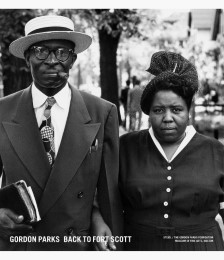-
Zusatztext
-
Gordon Parks returned to his hometown in southeastern Kansas in the spring of 1950 to make the series of photographs that would accompany an article for Life magazine meant to center on the issue of segregated schools and their impact on black children in the years prior to the Brown v. Board of Education of Topeka decision (1952-54). Fort Scott was the town that Parks had left more than twenty years earlier, and he used this assignment to revisit early memories of his birthplace, many involving serious racial discrimination, and to reconnect with his eleven members of his junior high school graduation class and discover what had become of them since his departure. When Parks arrived in 1950, only one member of the class remained in Fort Scott, while the rest had followed the well-worn paths of the Great Migration in search of better lives in urban centers, such as St. Louis, Kansas City, Columbus, OH, and Chicago. Heading out to those cities, Parks found his friends and their families and photographed them on their porches, in their parlors and dining rooms, on their way to church, and working at their jobs, and sat down to interview them about their decision to leave the segregated system of their youth and head north. His resulting photo essay and planned cover were finally slated to appear in Life in the spring of 1951, but were bumped from the magazine by Truman's firing of General MacArthur and in the end never published.
-
-
Autorenportrait
- Gordon Parks was born into poverty and segregation in Fort Scott, Kansas, in 1912. An itinerant laborer, he worked as a brothel pianist and railcar porter, among other jobs, before buying a camera at a pawnshop, training himself, and becoming a photographer. In addition to his storied tenures at the Farm Security Administration, the Office of War Information (1941-1945) and Life (1948-1972), Parks was a modern-day Renaissance man who found success as a film director, author and composer. The first African-American director to helm a major motion picture, he popularized the Blaxploitation genre through his film "Shaft" (1971). He wrote numerous memoirs, novels and books of poetry and received many awards, including the National Medal of Arts and more than fifty honorary degrees. In 1997 the Corcoran Gallery of Art in Washington, D.C., mounted his retrospective exhibition "Half Past Autumn: The Art of Gordon Parks." Parks died in 2006. Copublished with the Museum of Fine Arts Boston and The Gordon Parks Foundation Exhibition: Museum of Fine Arts Boston, January 17 to September 13, 2015
Detailansicht
Back to Fort Scott
Parks, Gordon/Haas, Karen/Wilkerson, Isabel et al
ISBN/EAN: 9783869309187
Umbreit-Nr.: 7611905
Sprache:
Englisch
Umfang: 144 S.
Format in cm: 2 x 29.6 x 25.7
Einband:
Leinen
Erschienen am 10.03.2015


